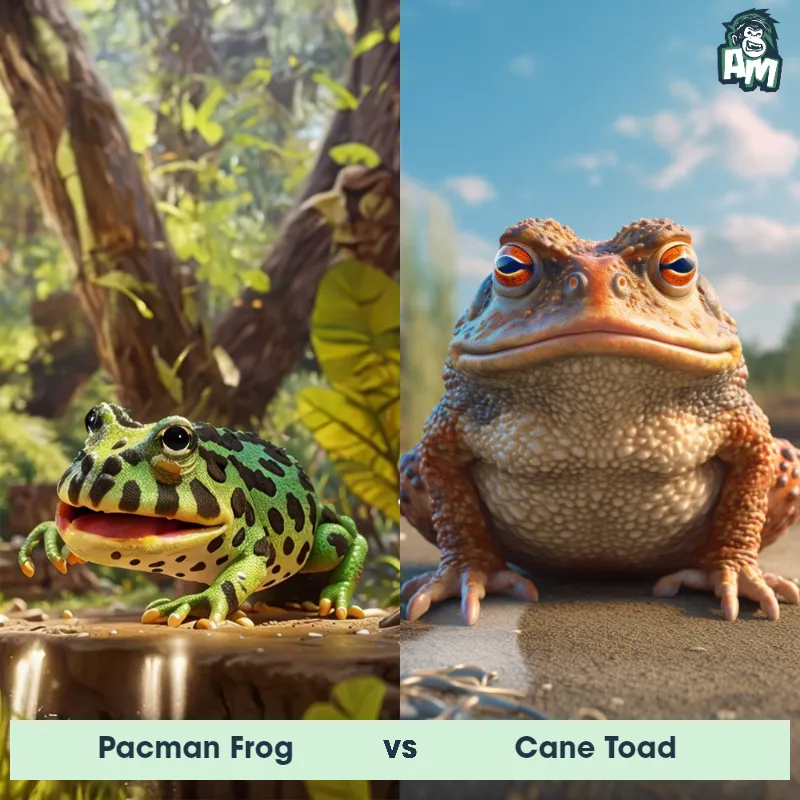Pacman Frog vs Cane ToadSee Who Wins

Welcome, ladies and gentlemen, to an exciting matchup between a Pacman Frog and a Cane Toad. Both of these amphibians are known for their powerful strikes and cunning tactics. It's bound to be a thrilling three-round fight.
Contender 1: Pacman Frog
The Pacman Frog, also known as the South American Horned Frog, is a species of frog native to South America. They are known for their large, round bodies and massive mouths, which they use to swallow prey whole. They come in various colors, including green, brown, and albino, and have distinct patterns and markings on their bodies. These frogs are relatively low-maintenance pets, as they are mostly sedentary and prefer to bury themselves in substrate.
Fun Fact: Pacman Frogs have a unique hunting strategy where they wait patiently for prey to come within reach, then snap their jaws shut quickly to catch their meal.
Contender 2: Cane Toad
The Cane Toad, also known as the Bufo marinus, is a large, terrestrial amphibian that can grow up to 9 inches in length. They have dry, warty skin that is typically brown or gray in color, with a creamy underbelly. Cane Toads are known for their distinctive parotoid glands located behind their eyes, which secrete a toxic substance that can be harmful to predators. They are native to Central and South America but have been introduced to other parts of the world, including Australia, where they are considered an invasive species.
Fun Fact: Cane Toads were introduced to Australia in the 1930s in an attempt to control the population of beetles that were damaging sugar cane crops, but the plan backfired as the toads had no natural predators and began to spread rapidly, causing harm to native wildlife.
Matchup Stats
| Pacman Frog | Cane Toad | |
|---|---|---|
| Size | Up to 4 inches (10 cm) | Up to 9 inches (22.86 cm) |
| Weight | Up to 2 pounds (900 grams) | Up to 4 pounds (1.81 kg) |
| Speed | 1-2 mph (1.6-3.2 km/h) | Speed: 5 mph (8 km/hr) |
| Key Strength | Bite force | Parotoid glands secrete toxic substance |
| Biggest Weakness | Slow movement | Slow movement |
Current Votes
Pacman Frog vs Cane Toad
See Who Wins
View More Matches
Looking For More?
Similar Matches
Scientific Stats
| Pacman Frog | Cane Toad | |
|---|---|---|
| Scientific Name | Ceratophrys cranwelli | Bufo marinus |
| Family | Ceratophryidae | Bufonidae |
| Habitat | Moist tropical forests, grasslands | Terrestrial |
| Geography | South America | Native to Central and South America, introduced to other parts of the world |
| Diet | Insects, small rodents, other frogs | Insects, small animals, plants |
| Lifespan | 5 years - 10 years | 5 years - 10 years |
Key Differences between Pacman Frog and Cane Toad
- Skin Texture: Pacman Frogs have smooth, waxy skin, while Cane Toads have rough, bumpy skin with prominent glands that secrete toxins.
- Size: The Pacman Frog is typically smaller in size, reaching an average length of only 4 inches, while the Cane Toad can grow to be over 6 inches in length.
- Habitat: Pacman Frogs are native to South America and inhabit damp, tropical forests, while Cane Toads are native to Central and South America, and have been introduced to various other regions including Australia and Florida, thriving in a wide range of habitats from rainforests to urban environments.
- Eyes: Pacman Frogs have large, bulging eyes positioned on the sides of their heads, while Cane Toads have smaller, more protruding eyes located closer together on top of their heads.
- Color: Pacman Frogs are known for their bright and vibrant colors, ranging from shades of red, orange, yellow, and green, whereas Cane Toads are usually dull and earthy in color, with shades of brown and beige.
- Body Shape: Pacman Frogs have a round, flattened body shape, resembling a pacman character, hence their name, while Cane Toads have a more oval-shaped body with a pronounced hump behind the head.
































